Hay usually consists of dried grass and herbs, it's primary use is as food for livestock.
For the less familiar with agricultural life: It is important to differentiate hay from straw, which is a byproduct of grain production. Straw is made out of dried stalks and is used for basketry, bedding, construction materials and sometimes also as food (but it has a very low nutrient content, in contrast to hay, and usually only serves as roughage, with hay actually supplying the needed nutrients)
Hay production:
First, the correct date for the cut needs to be picked. This is usually when the leaves are fully developed and the flowers are just before their prime. Cut to early, and the grass may be too wet, too late, and it looses nutritional value.
Second, the grass needs to be cut (usually with a sickle of scythe, but the cultured individual may employ sophisticated methods as just ripping the grass out with their bare hands).
Third, the grass needs to be dried. A simple and effective strategy is just scattering the cut grass on the ground and waiting for the sun to do the job. This process goes over multiple days, which creates a major problem: morning dew (and to a lesser extent, rain).
Historically, there were numerous methods to deal with this problem (which is the main reason this article exists).
1. The simplest method: Schwaden
The grass is arranged in the evening into piles on the ground, so the dew (or rain) reaches the least amount of drying grass. This method was by far the most prevalent.
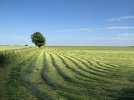
2. Heinzen (or in my dialect much prettier "Hoanza")
This method is mostly used in more rain heavy areas (like in the alps). Directly after the grass is cut, it is hung on stakes with crossbars above the ground. This reduces the amount of water the drying grass is exposed to, at the expense of a lot more work.
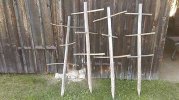
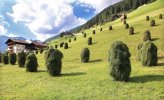
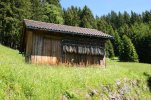
3. Schwedenreuter:
The idea is the same as above, but instead ropes are stretched between stakes, on which the freshly cut grass is hung. In contrast to the "Hoanza", this method couldn't be used as easily on sloped ground, so it's mostly seen in flat areas. It also requires bit less manual labour.
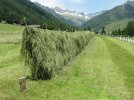
At the end of the drying process, the hay should not contain more than 15% water.









